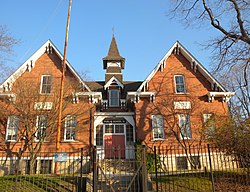
The Jerome Park Reservoir is a reservoir located in Jerome Park, a neighborhood in the North Bronx, New York City. The reservoir is surrounded by DeWitt Clinton High School, the Bronx High School of Science, Lehman College, and Walton High School.

The Bronx Community College of the City University of New York (BCC) is a public community college in the Bronx borough of New York City. It is part of the City University of New York system.

Wave Hill is a 28-acre (11 ha) estate in the Hudson Hill section of Riverdale in the Bronx, New York City. Wave Hill currently consists of public horticultural gardens and a cultural center, all situated on the slopes overlooking the Hudson River, with expansive views across the river to the New Jersey Palisades. The estate includes two houses and a botanical garden. The oldest part of the main house, Wave Hill House, dates back to 1843; Glyndor House dates from 1927 and contains a multi-room art gallery. Perkins Visitor Center, which was originally a garage, contains a gift shop and an information desk.
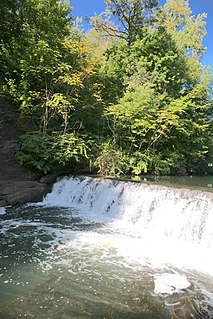
Bronx Park is a public park along the Bronx River, in the Bronx, New York City. The park is bounded by Southern Boulevard to the southwest, Webster Avenue to the northwest, Gun Hill Road to the north, Bronx Park East to the east, and East 180th Street to the south. With an area of 718 acres (2.91 km2), Bronx Park is the eighth-largest park in New York City.
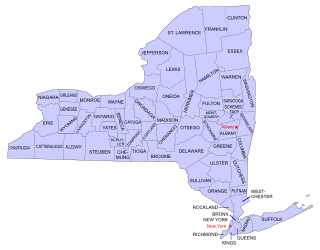
Buildings, sites, districts, and objects in New York listed on the National Register of Historic Places:
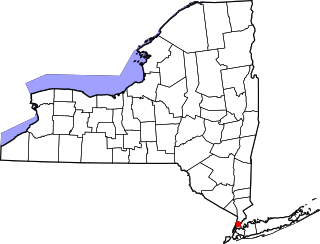
List of Registered Historic Places in Bronx County, New York :

List of the National Register of Historic Places listings in Kings County, New York
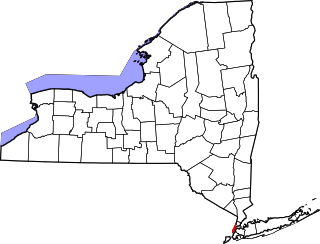
There are 566 properties and districts listed on the National Register of Historic Places in New York County, New York, which consists of Manhattan Island, the Marble Hill neighborhood on the mainland north of the Harlem River Ship Canal, and adjacent smaller islands around it.

List of the National Register of Historic Places listings in Richmond County, New York.

The Lorillard Snuff Mill now known as the Lillian and Amy Goldman Stone Mill, is the oldest existing tobacco manufacturing building in the United States. It was built around 1840 next to the Bronx River to supplement an earlier building of the same function. The schist that makes up its walls was quarried locally. It was declared a National Historic Landmark in 1977 and is located inside the New York Botanical Garden, itself an NHL.
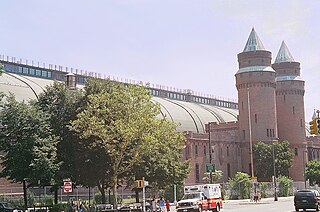
The Kingsbridge Armory, also known as the Eighth Regiment Armory, is located on West Kingsbridge Road in the New York City borough of the Bronx. It was built in the 1910s, from a design by the firm of then-state architect Lewis Pilcher to house the New York National Guard's Eighth Coast Defense Command, a regiment-sized unit which relocated from Manhattan in 1917. It is possibly the largest armory in the world.

Edgehill Church at Spuyten Duyvil is a United Church of Christ parish church located at 2550 Independence Avenue in the Spuyten Duyvil neighborhood of The Bronx, New York City. Its congregation was founded in 1869 as the mission chapel affiliated with the Riverdale Presbyterian Church, serving the workers at the nearby Johnson Iron Foundry. The church, described by the AIA Guide to New York City as a "picturesque eclectic sanctuary", was designed by architect Francis Kimball in a mixture of styles – Romanesque Revival, Tudor Revival and Shingle style – and was built from 1888–1889. It features stained glass windows designed by Louis Comfort Tiffany.

The Park Plaza Apartments were one of the first and most prominent art deco apartment buildings erected in the Bronx in New York City. The eight-story, polychromatic terra cotta embellished structure at 1005 Jerome Avenue and West 164th Street was designed by Horace Ginsberg and Marvin Fine and completed in 1931. It is an eight-story building divided into five blocks or section, each six bays wide. There are about 200 apartments, ranging from one to five rooms.

Williamsbridge Reservoir was a natural lake measuring 13.1 acres (5.3 ha) just south of Van Cortlandt Park in the Bronx, New York. Specifically the body of water was located at 208th Street and Bainbridge Avenue. It was shaped like a saucer and was normally 41 feet (12 m) deep. Its water level dropped approximately 14 feet (4.3 m) in mid-August 1901. On April 3, 1934 Commissioner of Water Supply, Gas and Electricity, Maurice P. Davidson, proposed that it be offered to Robert Moses to be used as a park site. The reservoir had ceased to be used after 1919.

Morris High School, in New York City, was a high school in the Melrose section of the Bronx borough's South Bronx area. The direct predecessor of Morris was built in 1897 and established as the Mixed High School, situated in a small brick building on 157th Street and 3rd Avenue, about six blocks south of where the new building would be built. It was the first high school built in the Bronx. Originally named Peter Cooper High School, the name was changed to Morris High School to commemorate a famous Bronx landowner, Gouverneur Morris, one of the signers of the United States Constitution and credited as author of its Preamble. Morris High School was one of the original New York City Public High Schools created by the New York City school reform act of 1896. On December 22, 1899, the Mixed High School was a founding member of the College Entrance Examination Board (CEEB), now known as the College Board. In 1983, the school and surrounding area was listed on the National Register of Historic Places as the Morris High School Historic District.

St. Ann's Church, also known as St. Ann's Church of Morrisania, is a historic Episcopal church in the Mott Haven, the South Bronx, New York City.

Public School 11, also known as Highbridge School, is a historic school located in The Bronx, New York City. It is a part of the New York City Department of Education (NYCDOE).

Public School 17 is a historic school located at City Island in the Bronx, New York City. It was designed by architect C. B. J. Snyder (1860–1945) and built in 1897 in the Neo-Georgian style. A rear addition was built in 1930. It is a two-story, five-bay brick building on a high basement. It features a shallow wooden entrance porch with Doric order columns.

The Keeper's House at Williamsbridge Reservoir is a historic home located in the Borough of the Bronx in New York City. It was built in 1889 as part of the Williamsbridge Reservoir complex. It is a 2 1⁄2-story, L-shaped stone house. The stones used to build the house were pieces of granite taken from the excavation of the reservoir it was to serve. It is 5,000 square feet (460 m2) in size and has a slate-covered gable roof with a clay tile roof ridge and copper gutters.

The Williamsbridge Oval is a park located in Norwood, Bronx, New York City. It is listed in the National Register of Historic Places.
